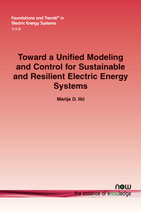Toward a Unified Modeling and Control for Sustainable and Resilient Electric Energy Systems
By Marija D. Ilic, Carnegie Mellon University, USA, milic@andrew.cmu.edu
Abstract
In this paper cyber role in social-ecological energy systems (SEES) is formalized by using the language of large-scale dynamical systems. The key notion of interaction variables is introduced in support of their modeling as multilayered dynamical systems. It is stressed that qualitatively different cyber designs are required for enabling performance of qualitatively different SEES architectures. In particular, it is proposed that composite control-based hierarchical control lends itself more naturally to supporting large-scale regulated monopolies, and that distributed multi-layered control with or without coordination is key to supporting SEES architectures comprising many decision makers. Today’s hierarchical control is described as a particular case of hierarchical composite control. Having these formulations may help bridge R&D efforts across vastly multi-disciplinary communities working in the field of changing electric energy systems.
Toward a Unified Modeling and Control for Sustainable and Resilient Electric Energy Systems
The electric power industry is reaching a tipping point at which technological, organizational and societal changes are extremely hard to reconcile. Different views are taken by different communities and the taxonomies used are hard to relate. This monograph considers the broad multi-disciplinary problem of providing sustainable and resilient electricity services. It introduces technology-agnostic unified modeling foundations and illustrates their use toward end-to-end cyber design for provable performance of complex electric energy systems.
In this monograph, the role of cyber social-ecological energy systems (SEES) is formalized by using the language of large-scale dynamical systems. The key notion of interaction variables is introduced in support of their modeling as multilayered dynamical systems. It is stressed that qualitatively different cyber designs are required for enabling performance of qualitatively different SEES architectures. In particular, it is proposed that composite control-based hierarchical control lends itself more naturally to supporting large-scale regulated monopolies, and that distributed multi-layered control with or without coordination is key to supporting SEES architectures comprising many decision makers. Today’s hierarchical control is described as a particular case of hierarchical composite control. Having these formulations may help bridge R&D efforts across vastly multi-disciplinary communities working in the field of changing electric energy systems.
